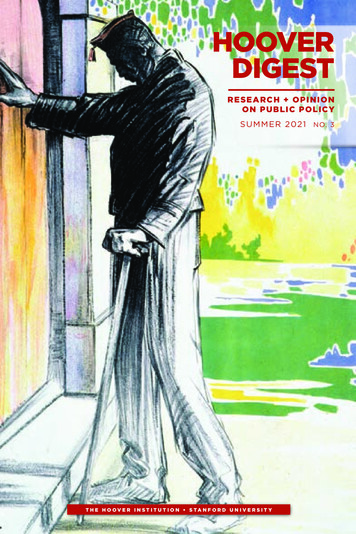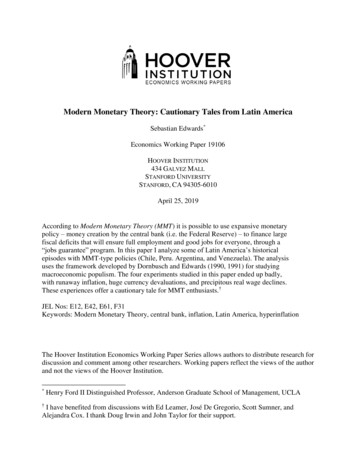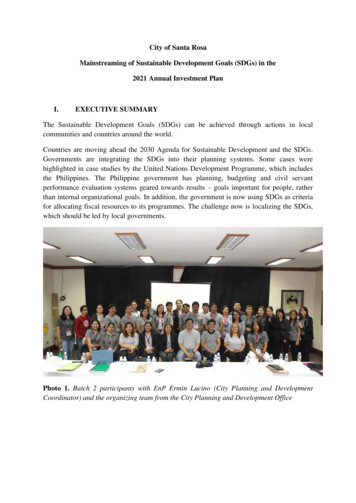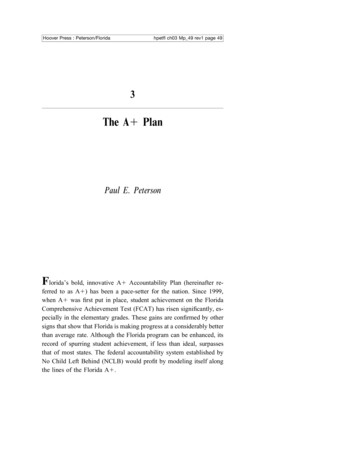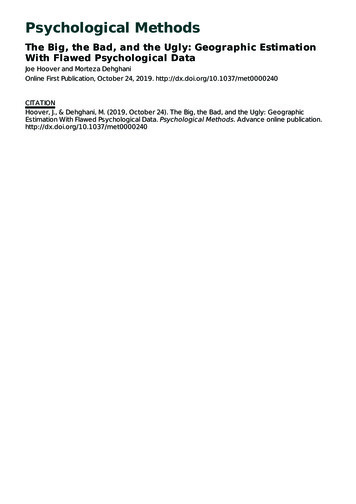
Transcription
rthe Rich”T h o m a s S o w e l lH O O V E R I N S T I T U T I O N P R E S SSTANFORD UNIVERSITY STANFORD, CALIFORNIASowell TrickleDown.indd i9/6/12 8:27 AM
The Hoover Institution on War, Revolution and Peace, foundedat Stanford University in 1919 by Herbert Hoover, who went onto become the thirty-first president of the United States, is aninterdisciplinary research center for advanced study on domesticand international affairs. The views expressed in its publications areentirely those of the authors and do not necessarily reflect the viewsof the staff, officers, or Board of Overseers of the Hoover Institution.www.hoover.orgHoover Institution Press Publication No. 635Hoover Institution at Leland Stanford Junior University,Stanford, California 94305-6010Copyright 2012 by Thomas SowellAll rights reserved. No part of this publication may be reproduced, storedin a retrieval system, or transmitted in any form or by any means, electronic,mechanical, photocopying, recording, or otherwise, without writtenpermission of the publisher and copyright holders.First printing 201218 17 16 15 14 13 12 7 6 5 4 3 2 1Manufactured in the United States of AmericaThe paper used in this publication meets the minimum Requirements of theAmerican National Standard for Information Sciences—Permanence of Paperfor Printed Library Materials, ANSI/NISO Z39.48-1992.Cataloging-in-Publication Data is available from the Library of Congress.ISBN: 978-0-8179-1615-2 (pbk. : alk. paper)ISBN: 978-0-8179-1616-9 (e-book)Sowell TrickleDown.indd ii9/6/12 8:27 AM
We fight for and against not men and things as they are, butfor and against the caricatures we make of them.J.A. Schumpeter1At various times and places, particular individuals have argued thatexisting tax rates are so high that the government could collect more taxrevenues if it lowered those tax rates, because the changed incentiveswould lead to more economic activity, resulting in more tax revenues outof rising incomes, even though the tax rate was lowered. This is clearlya testable hypothesis that people might argue for or against, on eitherempirical or analytical grounds. But that is seldom what happens.Even when the particular tax cut proposal is to cut tax rates in allincome brackets, including reducing tax rates by a higher percentage inthe lower income brackets than in the upper income brackets, such proposals have nevertheless often been characterized by their opponentsas “tax cuts for the rich” because the total amount of money saved bysomeone in the upper income brackets is often larger than the totalamount of money saved by someone in the lower brackets. Moreover, thereasons for proposing such tax cuts are often verbally transformed fromthose of the advocates— namely, changing economic behavior in waysthat generate more output, income and resulting higher tax revenues—to a very different theory attributed to the advocates by the opponents,namely “the trickle-down theory.”No such theory has been found in even the most voluminous andlearned histories of economic theories, including J.A. Schumpeter’smonumental 1,260-page History of Economic Analysis. Yet this Sowell TrickleDown.indd 119/6/12 8:27 AM
2“Trickle Down” Theory and “Tax Cuts for the Rich”non-existent theory* has become the object of denunciations from thepages of the New York Times and the Washington Post to the politicalarena. It has been attacked by Professor Paul Krugman of Princeton andProfessor Peter Corning of Stanford, among others, and similar attackshave been repeated as far away as India.2 It is a classic example of arguingagainst a caricature instead of confronting the argument actually made.While arguments for cuts in high tax rates have often been made byfree-market economists or by conservatives in the American sense, sucharguments have also sometimes been made by people who were neither,including John Maynard Keynes3 and Democratic Presidents WoodrowWilson4 and John F. Kennedy.5 But the claim that these are “tax cuts forthe rich,” based on a “trickle-down theory” also has a long pedigree.President Franklin D. Roosevelt’s speech writer Samuel Rosenmanreferred to “the philosophy that had prevailed in Washington since 1921,that the object of government was to provide prosperity for those wholived and worked at the top of the economic pyramid, in the belief thatprosperity would trickle down to the bottom of the heap and benefit all.”6The same theme was repeated in the election campaign of 2008, whenpresidential candidate Barack Obama attacked what he called “theeconomic philosophy” which “says we should give more and more to thosewith the most and hope that prosperity trickles down to everyone else.”7When Samuel Rosenman referred to what had been happening “since1921,” he was referring to the series of tax rate reductions advocatedby Secretary of the Treasury Andrew Mellon, and enacted into law byCongress during the decade of the 1920s. But the actual argumentsadvocated by Secretary Mellon had nothing to do with a “trickle-downtheory.” Mellon pointed out that, under the high income tax rates at theend of the Woodrow Wilson administration in 1921, vast sums of moneyhad been put into tax shelters such as tax-exempt municipal bonds, insteadof being invested in the private economy, where this money would create* Some years ago, in my syndicated column, I challenged anyone to name any economist, ofany school of thought, who had actually advocated a “trickle down” theory. No one quotedany economist, politician or person in any other walk of life who had ever advocated sucha theory, even though many readers named someone who claimed that someone else hadadvocated it, without being able to quote anything actually said by that someone else.Sowell TrickleDown.indd 29/6/12 8:27 AM
Thomas Sowell 3more output, incomes and jobs.8 It was an argument that would be madeat various times over the years by others— and repeatedly evaded byattacks on a “trickle-down” theory found only in the rhetoric of opponents.What actually followed the cuts in tax rates in the 1920s were risingoutput, rising employment to produce that output, rising incomes as aresult and rising tax revenues for the government because of therising incomes, even though the tax rates had been lowered. Anotherconsequence was that people in higher income brackets not only paid alarger total amount of taxes, but a higher percentage of all taxes, afterwhat have been called “tax cuts for the rich.” There were somewhatsimilar results in later years after high tax rates were cut during the JohnF. Kennedy, Ronald Reagan and George W. Bush administrations.9 Afterthe 1920s tax cuts, it was not simply that investors’ incomes rose but thatthis was now taxable income, since the lower tax rates made it profitablefor investors to get higher returns by investing outside of tax shelters.The facts are unmistakably plain, for those who bother to check thefacts. In 1921, when the tax rate on people making over 100,000 a yearwas 73 percent, the federal government collected a little over 700 millionin income taxes, of which 30 percent was paid by those making over 100,000. By 1929, after a series of tax rate reductions had cut the taxrate to 24 percent on those making over 100,000, the federal governmentcollected more than a billion dollars in income taxes, of which 65 percentwas collected from those making over 100,000.10There is nothing mysterious about this. Under the sharply rising taxrates during the Woodrow Wilson administration, to pay for the FirstWorld War, fewer and fewer people reported high taxable incomes,whether by putting their money into tax-exempt securities or by any of theother ways of rearranging their financial affairs to minimize their taxliability. Under these escalating wartime income tax rates, the number ofpeople reporting taxable incomes of more than 300,000— a huge sumin the money of that era— declined from well over a thousand in 1916 tofewer than three hundred in 1921. The total amount of taxable incomeearned by people making over 300,000 declined by more than four-fifthsduring those years.11 Since these were years of generally rising incomes,Sowell TrickleDown.indd 39/6/12 8:27 AM
4“Trickle Down” Theory and “Tax Cuts for the Rich”as Mellon pointed out, there was no reason to believe that the wealthywere suddenly suffering drastic reductions in their own incomes,12 butconsiderable reason to believe that they were receiving tax-exemptincomes that did not have to be reported under existing laws at that time.By the Treasury Department’s estimate, the money invested in taxexempt securities had nearly tripled in a decade.13 The total estimatedvalue of these securities was almost three times the size of the federalgovernment’s annual budget, and more than half as large as the nationaldebt.14 In short, these were sums of money with great potential impact onthe economy, depending on where they were invested.Andrew Mellon pointed out that “the man of large income hastended more and more to invest his capital in such a way that the taxcollector cannot reach it.”15 The value of tax-exempt securities, he said,“will be greatest in the case of the wealthiest taxpayer” and will be“relatively worthless” to a small investor, so that the cost of making upsuch tax losses by the government must fall on those other, non-wealthytaxpayers “who do not or cannot take refuge in tax-exempt securities.”16Mellon called it an “almost grotesque” result to have “higher taxes on allthe rest in order to make up the resulting deficiency in the revenues.”17Secretary Mellon repeatedly sought to get Congress to end taxexemptions for municipal bonds and other securities,18 pointing out theinefficiencies in the economy that such securities created.19 He also foundit “repugnant” in a democracy that there should be “a class in thecommunity which cannot be reached for tax purposes.” 20 SecretaryMellon said: “It is incredible that a system of taxation which permits aman with an income of 1,000,000 a year to pay not one cent to thesupport of his Government should remain unaltered.”21Congress, however, refused to put an end to tax-exempt securities.*They continued what Mellon called the “gesture of taxing the rich,”while in fact high tax rates on paper were “producing less and less* However economically inconsistent it was to have very high tax rates on high incomes,while providing a large loophole through which the wealthy could avoid paying thosetaxes, it was politically beneficial to elected officials, who could attract votes with classwarfare rhetoric and at the same time attract donations from the wealthy by providing aneasy escape from actually paying those taxes— and sometimes any taxes at all.Sowell TrickleDown.indd 49/6/12 8:27 AM
Thomas Sowell 5revenue each year and at the same time discouraging industry andthreatening the country’s future prosperity.”22 Unable to get Congress toend what he called “the evil of tax-exempt securities,”23 Secretary Mellonsought to reduce the incentives for investors to divert their money fromproductive investments in the economy to putting it into safe havens inthese tax shelters:Just as labor cannot be forced to work against its will, so it can betaken for granted that capital will not work unless the return isworth while. It will continue to retire into the shelter of tax-exemptbonds, which offer both security and immunity from the taxcollector.24In other words, high tax rates that many people avoid paying do notnecessarily bring in as much revenue to the government as lower taxrates that more people are in fact paying, when these lower tax ratesmake it safe to invest their money where they can get a higher rate ofreturn in the economy than they get from tax-exempt securities. Thefacts are plain: There were 206 people who reported annual taxableincomes of one million dollars or more in 1916. But, as the tax rates rose,that number fell drastically, to just 21 people by 1921. Then, after a seriesof tax rate cuts during the 1920s, the number of individuals reportingtaxable incomes of a million dollars or more rose again to 207 by 1925.25Under these conditions, it should not be surprising that the governmentcollected more tax revenue after tax rates were cut. Nor is it surprisingthat, with increased economic activity following the shift of vast sums ofmoney from tax shelters into the productive economy, the annualunemployment rate from 1925 through 1928 ranged from a high of4.2 percent to a low of 1.8 percent.26The point here is not simply that the weight of evidence is on one sideof the argument rather than the other but, more fundamentally, that therewas no serious engagement with the arguments actually advanced butinstead an evasion of those arguments by depicting them as simply a wayof transferring tax burdens from the rich to other taxpayers. WhatSenators Robert La Follette and Burton K. Wheeler said in their politicalSowell TrickleDown.indd 59/6/12 8:27 AM
6“Trickle Down” Theory and “Tax Cuts for the Rich”campaign literature during the 1924 election campaign— that “theMellon tax plan” was “a device to relieve multimillionaires at the expenseof other tax payers,” and “a master effort of the special privilege mind,”to “tax the poor and relieve the rich”27— would become perennial featuresof both intellectual and political discourse to the present day.Even in the twenty-first century, the same arguments used byopponents of tax cuts in the 1920s were repeated in the book WinnerTake-All Politics, whose authors refer to “the ‘trickle-down’ scenariothat advocates of helping the have-it-alls with tax cuts and other goodiesconstantly trot out.”28 No one who actually trotted out any such scenariowas cited, much less quoted.Repeatedly, over the years, the arguments of the proponents andopponents of tax rate reductions have been arguments about twofundamentally different things. Proponents of tax rate cuts base theirarguments on anticipated changes in behavior by investors in responseto reduced income tax rates. Opponents of tax cuts attribute to theproponents a desire to see higher income taxpayers have more after-taxincome, so that their prosperity will somehow “trickle down” to others,which opponents of tax cuts deny will happen. One side is talking aboutbehavioral changes that can change the total output of the economy, whilethe other side is talking about changing the direction of existing after-taxincome flows among people of differing income levels at existing levelsof output. These have been arguments about very different things, andthe two arguments have largely gone past each other untouched.Although Secretary of the Treasury Andrew Mellon was the keyfigure in getting tax rates lowered in the 1920s, he was by no means theonly, or the first, person to make the argument that tax rates can be sohigh as to fail to bring in more revenue. Members of both Democratic andRepublican administrations made that argument, as Mellon pointed out.29During the preceding Democratic administration of WoodrowWilson, Secretary of the Treasury Carter Glass said of tax rates in 1919that “the only consequence of any further increase would be to drivepossessors of these great incomes more and more to place their wealth inthe billions of dollars of wholly exempt securities.”30 Driving the moneySowell TrickleDown.indd 69/6/12 8:27 AM
Thomas Sowell 7of wealthy investors into tax-exempt state and municipal bonds hadconsequences for both the federal government’s tax revenue and for theeconomy in general, as Secretary Glass spelled out:This process not only destroys a source of revenue to the FederalGovernment, but tends to withdraw the capital of very rich menfrom the development of new enterprises and place it at the disposalof State and municipal governments upon terms so easy to them . . .as to stimulate wasteful and nonproductive expenditure by State andmunicipal governments.31One year later, another Secretary of the Treasury in the WoodrowWilson administration made essentially the same argument, saying thathigh taxes on high incomes “have passed the point of maximum productivityand are rapidly driving the wealthier taxpayers to transfer their investmentsinto the thousands of millions of tax-free securities which compete sodisastrously with the industrial and railroad securities upon the readypurchase of which the development of industry and the expansion offoreign trade intimately depend.”32 Secretary David Franklin Houstonpointed out that the taxable income of people who earned 300,000 andup in 1916 had been more than cut in half by 1918— not because hethought their total incomes had gone down but “almost certainly throughinvestment by the richer taxpayers in tax-exempt properties.”33President Woodrow Wilson made a very similar argument in his1919 message to Congress:The Congress might well consider whether the higher ratesof income and profits taxes can in peace times be effectivelyproductive of revenue, and whether they may not, on the contrary,be destructive of business activity and productive of waste andinefficiency. There is a point at which in peace times high rates ofincome and profits taxes discourage energy, remove the incentive tonew enterprise, encourage extravagant expenditures, and produceindustrial stagnation with consequent unemployment and otherattendant evils.34Sowell TrickleDown.indd 79/6/12 8:27 AM
8“Trickle Down” Theory and “Tax Cuts for the Rich”At this point, there was not yet a sharp and pervasive partisandifference on either the desirability of lowering high tax rates on highincome taxpayers or on the reasons for doing so. Nor did either partyargue that lower tax rates would create prosperity at the top that would“trickle down” to others. President Calvin Coolidge was in fact quiteexplicit that the primary purpose of lowering tax rates was for thegovernment to collect more tax revenues:The first object of taxation is to secure revenue. When the taxationof large incomes is approached with this in view, the problem is tofind a rate which will produce the largest returns. Experience doesnot show that the higher rate produces the larger revenue. . . .I agree perfectly with those who wish to relieve the smalltaxpayer by getting the largest possible contribution from the peoplewith large incomes. But if the rates on large incomes are so high thatthey disappear, the small taxpayer will be left to bear the entireburden.35Although there were some political attacks in the 1920s on Mellon’stax-cutting plans, there was not yet the utter political polarization over“tax cuts for the rich” that characterized the later years of the twentiethcentury and the early years of the twenty-first. Nor was there the sameideological polarization in earlier times. It was none other than JohnMaynard Keynes who said, in 1933, that “taxation may be so high asto defeat its object,” that “given sufficient time to gather the fruits, areduction of taxation will run a better chance, than an increase, ofbalancing the Budget.”36In 1962, Democratic President John F. Kennedy, like both Democraticand Republican Presidents and Secretaries of the Treasury in earlier years,pointed out that “it is a paradoxical truth that tax rates are too high todayand tax revenues are too low and the soundest way to raise the revenuesin the long run is to cut the rates now.” This was because investors’“efforts to avoid tax liabilities” make “certain types of less productiveactivity more profitable than other more valuable undertakings” and “thisSowell TrickleDown.indd 89/6/12 8:27 AM
Thomas Sowell 9inhibits our growth and efficiency.” Therefore the “purpose of cuttingtaxes” is “to achieve the more prosperous, expanding economy.”37 “Totaloutput and economic growth” were italicized words in the text of JohnF. Kennedy’s address to Congress in January 1963, urging cuts in taxrates.38 In short, President Kennedy was talking about inducing changesin behavior designed to increase aggregate output, not changing theallocation of existing income flows, in hopes that more prosperity atthe top would “trickle down.”Much the same theme was repeated yet again in President RonaldReagan’s February 1981 address to a joint session of Congress, pointingout that “this is not merely a shift of wealth between different sets oftaxpayers.” Instead, basing himself on a “solid body of economicexperts,” he expected that “real production in goods and services willgrow.”39 In short, President Reagan was likewise not talking about aftertax income flows but about changes in behavior anticipated to increaseaggregate output in the wake of changing tax rates. In 2001, PresidentGeorge W. Bush proposed his tax rate cuts, citing the Kennedyadministration and Reagan administration precedents.40In short, neither these earlier nor later arguments for cuts in tax rateshad anything to do with making some people more prosperous, so thattheir prosperity might “trickle down” to others. But empirical evidenceon what was actually said and done, as well as the actual consequencesof tax cuts in four different administrations over a span of more thaneighty years have also been largely ignored by those opposed to whatthey call “tax cuts for the rich.”Confusion between reducing tax rates on individuals and reducingtax revenues received by the government has run through much ofthese discussions over these many years. Famed historian ArthurM. Schlesinger, Jr., for example, said that although Andrew Mellonadvocated balancing the budget and paying off the national debt,he “inconsistently” sought a “reduction of tax rates.” 41 In reality, thenational debt was reduced, as more revenue came into the governmentunder the lowered tax rates. The national debt was just under 24 billionin 1921 and it was reduced to under 18 billion in 1928.42 Nor wasSowell TrickleDown.indd 99/6/12 8:27 AM
10“Trickle Down” Theory and “Tax Cuts for the Rich”Professor Schlesinger the only highly regarded historian to perpetuateeconomic confusion between tax rates and tax revenues.Today, widely used textbooks, written by various well-knownhistorians, have continued to grossly misstate what was advocated in the1920s and what the actual consequences were. According to the textbookThese United States by Pulitzer Prize winner Professor Irwin Unger ofNew York University, Secretary of the Treasury Andrew Mellon, “a richPittsburgh industrialist,” persuaded Congress to “reduce income tax ratesat the upper levels while leaving those at the bottom untouched.” Thus“Mellon won further victories for his drive to shift more of the tax burdenfrom high-income earners to the middle and wage-earning classes.”43 Buthard data show that, in fact, both the amount and the proportion of taxespaid by those whose net income was no higher than 25,000 went downbetween 1921 and 1929, while both the amount and the proportion of taxespaid by those whose net incomes were between 50,000 and 100,000went up— and the amount and proportion of taxes paid by those whosenet incomes were over 100,000 went up even more sharply.44Another widely used textbook, co-authored by a number ofdistinguished historians, two of whom won Pulitzer Prizes, saidof Andrew Mellon: “It was better, he argued, to place the burden of taxeson lower-income groups” and that a “share of the tax-free profits of therich, Mellon reassured the country, would ultimately trickle down tothe middle- and lower-income groups in the form of salaries and wages.”45What Mellon actually said was that tax policy “must lessen, so far aspossible, the burden of taxation on those least able to bear it.” 46 Hetherefore proposed sharper percentage cuts in tax rates at the lowerincome levels47— and that was done. Mellon also proposed eliminatingfederal taxes on movie tickets, on grounds that such taxes were paid by“the great bulk of the people whose main source of recreation is attendingthe movies in the neighborhood of their homes.” 48 In short, Mellonadvocated the direct opposite of the policies attributed to him.The very idea that profits “trickle down” to workers depicts theeconomic sequence of events in the opposite order from that in the realworld. Workers must first be hired, and commitments made to pay them,Sowell TrickleDown.indd 109/6/12 8:27 AM
Thomas Sowell 11before there is any output produced to sell for a profit, and independentlyof whether that output subsequently sells for a profit or at a loss. Withmany investments, whether they lead to a profit or a loss can often bedetermined only years later, and workers have to be paid in the meantime,rather than waiting for profits to “trickle down” to them. The real effectof tax rate reductions is to make the future prospects of profit lookmore favorable, leading to more current investments that generate morecurrent economic activity and more jobs.Those who attribute a trickle-down theory to others are attributingtheir own misconception to others, as well as distorting both thearguments used and the hard facts about what actually happened afterthe recommended policies were put into effect.Another widely used history textbook, a best-seller titled TheAmerican Nation by Professor John Garraty of Columbia University,said that Secretary Mellon “opposed lower rates for taxpayers earningless than 66,000.”49 Still another best-selling textbook, The AmericanPageant with multiple authors, declared: “Mellon’s spare-the-richpolicies thus shifted much of the tax burden from the wealthy to themiddle-income groups.”50There is no need to presume that the scholars who wrote thesehistory textbooks were deliberately lying, in order to protect a vision oran agenda. They may simply have relied on a peer consensus so widelyheld and so often repeated as to be seen as “well-known facts” requiringno serious re-examination. The results show how unreliable peerconsensus can be, even when it is a peer consensus of highly intellectualpeople, if those people share a very similar vision of the world and treatits conclusions as axioms, rather than as hypotheses that need to bechecked against facts. These history textbooks may also ref lectthe economic illiteracy of many leading scholars outside the field ofeconomics, who nevertheless insist on proclaiming their conclusionson economic issues.When widely recognized scholars have been so cavalier, it is hardlysurprising that the media have followed suit. For example, New YorkTimes columnist Tom Wicker called the Reagan administration’s tax cutsSowell TrickleDown.indd 119/6/12 8:27 AM
12“Trickle Down” Theory and “Tax Cuts for the Rich”“the old Republican ‘trickle-down’ faith.”51 Washington Post columnistDavid S. Broder called these tax cuts “feeding the greed of the rich”while “adding to the pain of the poor”— part of what he called the“moral meanness of the Reagan administration.”52 Under the headline,“Resurrection of Coolidge,” another Washington Post columnist,Haynes Johnson, characterized the Reagan tax rate cuts as part of the“help-the-rich-first, and let-the-rest-trickle-down philosophies.”53John Kenneth Galbraith characterized the “trickle-down effect” asparallel to “the horse-and-sparrow metaphor, holding that if the horse isfed enough oats, some will pass through to the road for the sparrows.”54Similar characterizations of a “trickle-down” theory were common inop-ed columns by Leonard Silk, Alan Brinkley and other well-knownwriters of the time, as well as in New York Times editorials.55Responses to later tax cut proposals during the George W. Bushadministration included denunciations of “trickle-down” economicsfrom, among others, Arthur M. Schlesinger, Jr., Paul Krugman, andJonathan Chait. Washington Post columnist David S. Broder denounced“the financial bonanza that awaits the wealthiest Americans in the Bushplan.”56Implicit in the approach of both academic and media critics of whatthey call “tax cuts for the rich” and a “trickle-down theory” is a zerosum conception of the economy, where the benefits of some come atthe expense of others. That those with such a zero-sum conception of theeconomy often show little or no interest in the factors affectingthe creation of wealth— as distinguished from their preoccupation withits distribution— is consistent with their vision, however inconsistent itis with the views of others who are focussed on the growth of theeconomy, as emphasized by both Presidents John F. Kennedy and RonaldReagan, for example.What is also inconsistent is attributing one’s own assumptions tothose who are arguing on the basis of entirely different assumptions.Challenging those other assumptions, or the conclusions which derivefrom them, on either analytical or empirical grounds would be legitimate,but simply attributing to them arguments that they never made is not.Sowell TrickleDown.indd 129/6/12 8:27 AM
Thomas Sowell 13Even when empirical evidence substantiates the arguments madefor cuts in tax rates, such facts are not treated as evidence relevant totesting a disputed hypothesis, but as isolated curiosities. Thus, when taxrevenues rose in the wake of the tax rate cuts made during the GeorgeW. Bush administration, the New York Times reported: “An unexpectedlysteep rise in tax revenues from corporations and the wealthy is drivingdown the projected budget deficit this year.”57 Expectations, of course,are in the eye of the beholder. However surprising the increases in taxrevenues may have been to the New York Times, they are exactly whatproponents of reducing high tax rates have been expecting, not only fromthese particular tax rate cuts, but from similar reductions in high taxrates at various times going back more than three-quarters of a century.To the extent that the American economy has changed since thetime of Andrew Mellon, it has changed in ways that make it even easierfor wealthy investors to escape high tax rates. A globalized economymakes overseas investment
attacks on a "trickle-down" theory found only in the rhetoric of opponents. What actually followed the cuts in tax rates in the 1920s were rising output, rising employment to produce that output, rising incomes as a result and rising tax revenues for the government because of the rising incomes, even though the tax had been lowered. Another .
